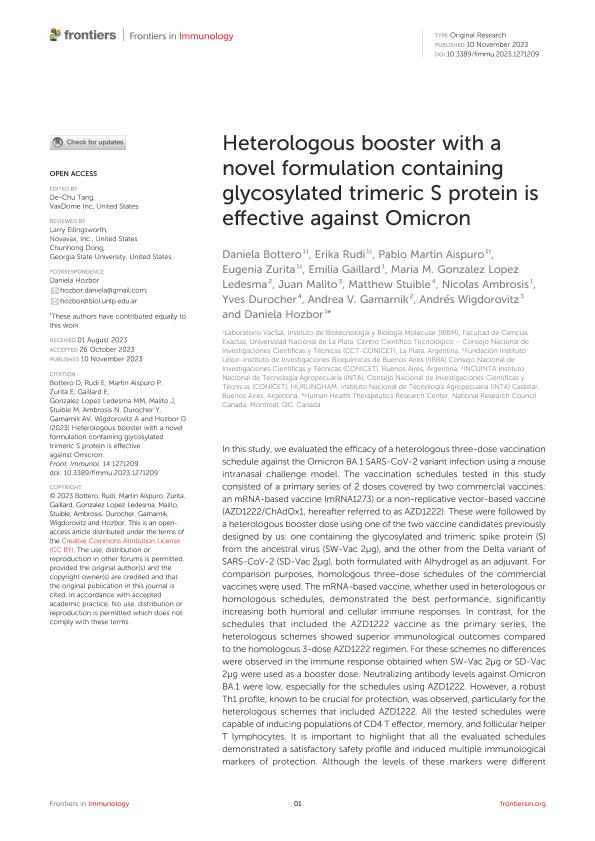Artículo
Heterologous booster with a novel formulation containing glycosylated trimeric S protein is effective against Omicron
Bottero, Daniela ; Rudi, Erika
; Rudi, Erika ; Martin Aispuro, Pablo
; Martin Aispuro, Pablo ; Zurita, Maria Eugenia
; Zurita, Maria Eugenia ; Gaillard, María Emilia
; Gaillard, María Emilia ; González López Ledesma, María Mora
; González López Ledesma, María Mora ; Malito, Juan; Stuible, Matthew; Ambrosis, Nicolás Martín
; Malito, Juan; Stuible, Matthew; Ambrosis, Nicolás Martín ; Durocher, Yves; Gamarnik, Andrea Vanesa
; Durocher, Yves; Gamarnik, Andrea Vanesa ; Wigdorovitz, Andrés
; Wigdorovitz, Andrés ; Hozbor, Daniela Flavia
; Hozbor, Daniela Flavia
 ; Rudi, Erika
; Rudi, Erika ; Martin Aispuro, Pablo
; Martin Aispuro, Pablo ; Zurita, Maria Eugenia
; Zurita, Maria Eugenia ; Gaillard, María Emilia
; Gaillard, María Emilia ; González López Ledesma, María Mora
; González López Ledesma, María Mora ; Malito, Juan; Stuible, Matthew; Ambrosis, Nicolás Martín
; Malito, Juan; Stuible, Matthew; Ambrosis, Nicolás Martín ; Durocher, Yves; Gamarnik, Andrea Vanesa
; Durocher, Yves; Gamarnik, Andrea Vanesa ; Wigdorovitz, Andrés
; Wigdorovitz, Andrés ; Hozbor, Daniela Flavia
; Hozbor, Daniela Flavia
Fecha de publicación:
11/2023
Editorial:
Frontiers Media
Revista:
Frontiers in Immunology
ISSN:
1664-3224
Idioma:
Inglés
Tipo de recurso:
Artículo publicado
Clasificación temática:
Resumen
In this study, we evaluated the efficacy of a heterologous three-dose vaccination schedule against the Omicron BA.1 SARS-CoV-2 variant infection using a mouse intranasal challenge model. The vaccination schedules tested in this study consisted of a primary series of 2 doses covered by two commercial vaccines: an mRNA-based vaccine (mRNA1273) or a non-replicative vector-based vaccine (AZD1222/ChAdOx1, hereafter referred to as AZD1222). These were followed by a heterologous booster dose using one of the two vaccine candidates previously designed by us: one containing the glycosylated and trimeric spike protein (S) from the ancestral virus (SW-Vac 2µg), and the other from the Delta variant of SARS-CoV-2 (SD-Vac 2µg), both formulated with Alhydrogel as an adjuvant. For comparison purposes, homologous three-dose schedules of the commercial vaccines were used. The mRNA-based vaccine, whether used in heterologous or homologous schedules, demonstrated the best performance, significantly increasing both humoral and cellular immune responses. In contrast, for the schedules that included the AZD1222 vaccine as the primary series, the heterologous schemes showed superior immunological outcomes compared to the homologous 3-dose AZD1222 regimen. For these schemes no differences were observed in the immune response obtained when SW-Vac 2µg or SD-Vac 2µg were used as a booster dose. Neutralizing antibody levels against Omicron BA.1 were low, especially for the schedules using AZD1222. However, a robust Th1 profile, known to be crucial for protection, was observed, particularly for the heterologous schemes that included AZD1222. All the tested schedules were capable of inducing populations of CD4 T effector, memory, and follicular helper T lymphocytes. It is important to highlight that all the evaluated schedules demonstrated a satisfactory safety profile and induced multiple immunological markers of protection. Although the levels of these markers were different among the tested schedules, they appear to complement each other in conferring protection against intranasal challenge with Omicron BA.1 in K18-hACE2 mice. In summary, the results highlight the potential of using the S protein (either ancestral Wuhan or Delta variant)-based vaccine formulation as heterologous boosters in the management of COVID-19, particularly for certain commercial vaccines currently in use.
Palabras clave:
COVID-19
,
HETEROLOGOUS BOOSTER
,
OMICRON
,
SARS- COV-2
,
SPIKE-BASED VACCINE
Archivos asociados
Licencia
Identificadores
Colecciones
Articulos(IBBM)
Articulos de INST.DE BIOTECNOLOGIA Y BIOLOGIA MOLECULAR
Articulos de INST.DE BIOTECNOLOGIA Y BIOLOGIA MOLECULAR
Articulos(IIBBA)
Articulos de INST.DE INVEST.BIOQUIMICAS DE BS.AS(I)
Articulos de INST.DE INVEST.BIOQUIMICAS DE BS.AS(I)
Citación
Bottero, Daniela; Rudi, Erika; Martin Aispuro, Pablo; Zurita, Maria Eugenia; Gaillard, María Emilia; et al.; Heterologous booster with a novel formulation containing glycosylated trimeric S protein is effective against Omicron; Frontiers Media; Frontiers in Immunology; 14; 11-2023; 1-15
Compartir
Altmétricas



